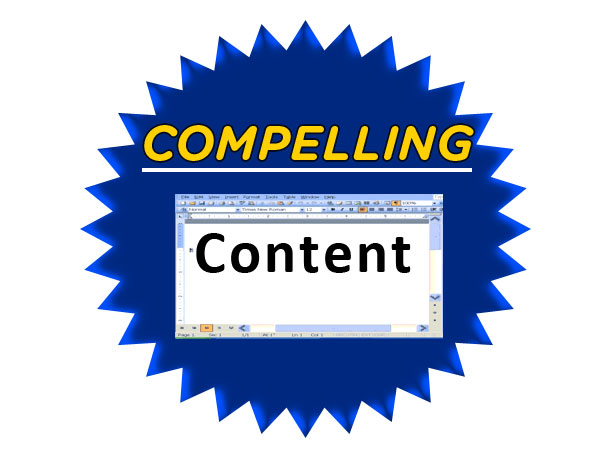
Have you noticed the emergence of blogs on small, medium and large sized business websites? Now more than ever, businesses are relying on blogs and social media for exposure, reputation, marketing and sales. In my last entry I talked about what Google’s PageRank is and how it increases when your website has more ‘votes’ or backlinks from other places on the web. Getting backlinks the correct and organic way isn’t always easy, especially if you don’t already have a large following. If you do have a large fan and customer base however, a blog can help increase sales from current customers and generate new sources of lead generation in ways you may not have considered before. Connecting with a visitor through text is much harder than speaking face to face, watching a video, or even listening to audio; but worth its weight in gold when done properly.
The topic of today’s post is all about compelling content. While compelling content is necessary for and can be explained in depth for sales copy and landing pages, homepage retention, flyers, advertising campaigns and more; today will be about a blog. In the not so distant past, blogs were a way for individuals to share their experiences and their photographs and memories with close ones and people from around the world. The internet allowed them to have their voices heard, and even make a little money in the process. Today however, a blog is much more than just a personal space for rambling. A blog is a way to keep readers interested and to provide value and recognition. As you read this post, remember that you are reading a blog right now, and my goal is to provide a resource packed with information on why compelling content and blogs are important in today’s business world.
Content that Begs to be Shared
 Setting up a blog is the easy part, maintaining it on the other hand is another story and is not always done properly by businesses. As you write, each post should be providing the targeted reader with something valuable, not just telling them how your sales projections and growth figures are for the quarter. Place yourself in the mind of a reader and anticipate what they would like to know more about and what they could learn from your industry and expertise. This is the start to creating compelling content.
Setting up a blog is the easy part, maintaining it on the other hand is another story and is not always done properly by businesses. As you write, each post should be providing the targeted reader with something valuable, not just telling them how your sales projections and growth figures are for the quarter. Place yourself in the mind of a reader and anticipate what they would like to know more about and what they could learn from your industry and expertise. This is the start to creating compelling content.
When you create content that is both usable and valuable, it begs to be shared. Keep the reader on the edge of their seat; keep them interested in learning and wondering what is coming next. Have you ever read a blog post or an article that was so well written, informative and significant that it made you take a moment and reflect how great it was? I’ll be honest, after working mainly online for several years now I can easily sift through the page filler content and content that is truly unique and compelling. Because of this, I don’t share or link to stuff very often, but when I do – it deserves it. This is the foundation of compelling content and creating value through words in an article, connecting with the reader.
Topics may be hard at first, but it will gradually become easier and starting to get feedback from readers will often spawn new topics of discussion and future post ideas. If you were a news outlet or celebrity gossip website it might be a bit easier to get shares and links because people thrive on that sort of information without needing anything more compelling than a well written title. In the business world, certain topics can be dry and words can be boring, but those who are creative always find a way to separate it and make it interesting in a way that benefits both the business and the reader. How to’s, explanations, and tips and tricks are all examples of value and usefulness that will often lead to following and linking to.
The End Goal: Retaining Readers & Customers
 You should understand what compelling content is and why it’s important by now, but you still may be asking yourself what the end goal is from all of this? As I mentioned earlier it’s all about retention, branding, and being an authority source. A blog will work to effectively get natural backlinks and engage and retain readers. Your end goal should be to have a means for the reader to connect with you and stay connected. If your blog is as informative and value rich as it should be, a reader will want more and you will have to give them more. At the end of your blog posts or somewhere else on the page, you need to include a newsletter signup field. Every time you publish a new blog post you can also send out a newsletter with a preview of the new blog post to get the reader excited and then finish reading it on your website. With the right newsletter software, you can track conversions and how many people clicked through to read the post; using this data to tweak your future approach. You shouldn’t be pushing products down your reader’s throats or sending them too many notifications, but I will talk about the art of newsletters and retaining your list of readers in another post in the future.
You should understand what compelling content is and why it’s important by now, but you still may be asking yourself what the end goal is from all of this? As I mentioned earlier it’s all about retention, branding, and being an authority source. A blog will work to effectively get natural backlinks and engage and retain readers. Your end goal should be to have a means for the reader to connect with you and stay connected. If your blog is as informative and value rich as it should be, a reader will want more and you will have to give them more. At the end of your blog posts or somewhere else on the page, you need to include a newsletter signup field. Every time you publish a new blog post you can also send out a newsletter with a preview of the new blog post to get the reader excited and then finish reading it on your website. With the right newsletter software, you can track conversions and how many people clicked through to read the post; using this data to tweak your future approach. You shouldn’t be pushing products down your reader’s throats or sending them too many notifications, but I will talk about the art of newsletters and retaining your list of readers in another post in the future.
For now, understand that it is crucial to create a following through newsletter signups and even through social media. A blog post can generate traffic from current subscribers of your newsletter as well as organic traffic from search engines. While some people may not want to sign up to a newsletter, they may like you on Facebook or another social outlet where you can also send out a notification about a new blog post and its topic. The more value you provide your readers the more they will share and link to your content, which will increase the authority of your website at the same time. If you are providing value, then you are also building trust amongst your readers. When you have trust, you will be able to market your products and services in a way that isn’t force fed and your conversions and sales will be much higher than you ever thought were possible from a blog.

Share